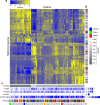Decoding tumour phenotype by noninvasive imaging using a quantitative radiomics approach
- PMID: 24892406
- PMCID: PMC4059926
- DOI: 10.1038/ncomms5006
Decoding tumour phenotype by noninvasive imaging using a quantitative radiomics approach
Erratum in
- Nat Commun. 2014;5:4644. Cavalho, Sara [corrected to Carvalho, Sara]
Abstract
Human cancers exhibit strong phenotypic differences that can be visualized noninvasively by medical imaging. Radiomics refers to the comprehensive quantification of tumour phenotypes by applying a large number of quantitative image features. Here we present a radiomic analysis of 440 features quantifying tumour image intensity, shape and texture, which are extracted from computed tomography data of 1,019 patients with lung or head-and-neck cancer. We find that a large number of radiomic features have prognostic power in independent data sets of lung and head-and-neck cancer patients, many of which were not identified as significant before. Radiogenomics analysis reveals that a prognostic radiomic signature, capturing intratumour heterogeneity, is associated with underlying gene-expression patterns. These data suggest that radiomics identifies a general prognostic phenotype existing in both lung and head-and-neck cancer. This may have a clinical impact as imaging is routinely used in clinical practice, providing an unprecedented opportunity to improve decision-support in cancer treatment at low cost.
Figures




Comment in
-
[Vulnerabilities of radiomics: Why the most popular radiomics signature accidentally measured tumor volume].Strahlenther Onkol. 2021 Apr;197(4):361-364. doi: 10.1007/s00066-021-01747-8. Epub 2021 Feb 3. Strahlenther Onkol. 2021. PMID: 33537912 Free PMC article. German. No abstract available.
References
-
- Buckler A. J., Bresolin L., Dunnick N. R. & Sullivan D. C. Group. A collaborative enterprise for multi-stakeholder participation in the advancement of quantitative imaging. Radiology 258, 906–914 (2011). - PubMed
-
- Jaffe C. C. Measures of response: RECIST, WHO, and new alternatives. J. Clin. Oncol. 24, 3245–3251 (2006). - PubMed
Publication types
MeSH terms
Grants and funding
LinkOut - more resources
Full Text Sources
Other Literature Sources
Medical
Molecular Biology Databases

